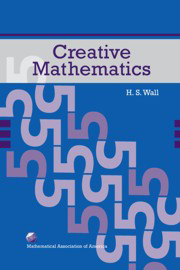Book contents
- Frontmatter
- Foreword
- Preface
- Contents
- Short Biography of H. S. Wall
- 1 Numbers
- 2 Ordered Number Pairs
- 3 Slope
- 4 Combinations of Simple Graphs
- 5 Theorems about Simple Graphs
- 6 The Simple Graphs of Trigonometry
- 7 The Integral
- 8 Computation Formulas Obtained by Means of the Integral
- 9 Simple Graphs Made to Order
- 10 More about Integrals
- 11 Simple Surfaces
- 12 Successive Approximations
- 13 Linear Spaces of Simple Graphs
- 14 More about Linear Spaces
- 15 Mechanical Systems
- Integral Tables
- Index of Simple Graphs
- Glossary of Definitions
Short Biography of H. S. Wall
- Frontmatter
- Foreword
- Preface
- Contents
- Short Biography of H. S. Wall
- 1 Numbers
- 2 Ordered Number Pairs
- 3 Slope
- 4 Combinations of Simple Graphs
- 5 Theorems about Simple Graphs
- 6 The Simple Graphs of Trigonometry
- 7 The Integral
- 8 Computation Formulas Obtained by Means of the Integral
- 9 Simple Graphs Made to Order
- 10 More about Integrals
- 11 Simple Surfaces
- 12 Successive Approximations
- 13 Linear Spaces of Simple Graphs
- 14 More about Linear Spaces
- 15 Mechanical Systems
- Integral Tables
- Index of Simple Graphs
- Glossary of Definitions
Summary
Creative Mathematics is intimately tied to the author's background and career. Hubert Stanley Wall was born in Rockwell City, Iowa, 2 December 1902. He graduated from the local high school in 1920. He then went to Cornell College in Mt. Vernon, Iowa, where in 1924 he obtained BA and MA degrees with undergraduate work in languages, physics, chemistry and mathematics, and graduate work in mathematics and mathematical physics. Wall's principal influence there—and perhaps the one which led him into mathematics in the first place—was Elmer Moots (1882–1970) to whom in 1944 he dedicated one of his publications. Moots had a reputation at the University of Wisconsin—Madison for referring top-class students to them for graduate work and H.S. Wall was evidently one of these in 1924. He earned his PhD there in 1927 with the dissertation topic: “On the Padé Approximants Associated with the Continued Fraction and Series of Stieltjes.”
At Madison his thesis advisor was E. B. Van Vleck, a native of Connecticut who earned his degree in 1893 under Felix Klein, the head of the pre-eminent world center of mathematics at Göttingen University in Germany. When Van Vleck died in 1943 Wall wrote in an article submitted to the Bulletin of the American Mathematical Society that he “was profoundly influenced by the teaching and discoveries of Van Vleck,” who “loved to explore and survey wide areas, and to teach. In his reading he liked to pick out only the definitions and theorems and then to supply his own proofs.”
- Type
- Chapter
- Information
- Creative Mathematics , pp. xvii - xxiiPublisher: Mathematical Association of AmericaPrint publication year: 2009



